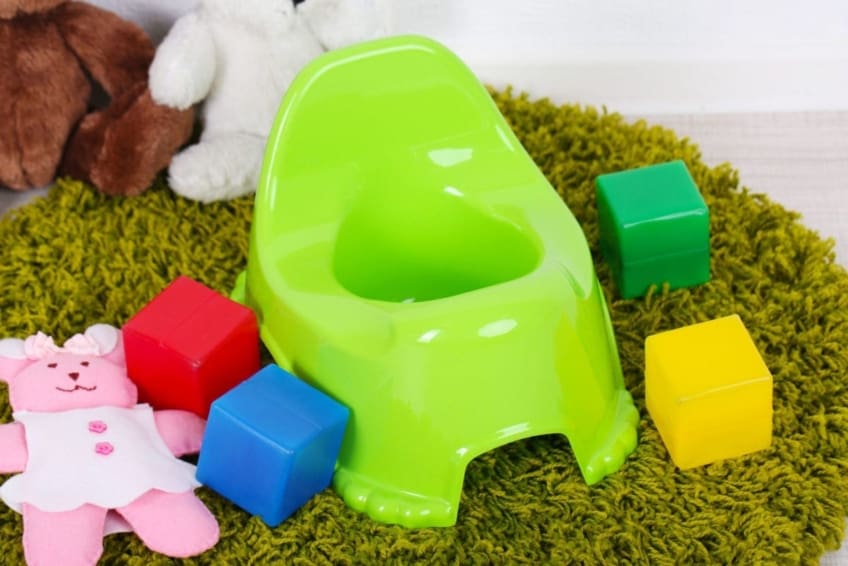
Children go through many milestones as they grow. One of the biggest—for them and for you—is learning to use the toilet. Parents often have questions about when and how to toilet train (potty train) their child. Here are some answers.
Path to improved well being
When should I start toilet training my child?
Do not start toilet training until both you and your child are ready. You are ready when you are able to devote the time and energy necessary to encourage your child on a daily basis. Your child will start showing signs that they are ready when they:
- Signal that their diaper is wet or soiled
- Seem interested in the potty chair or toilet
- Go to another spot or room to urinate or have a bowel movement
- Show interest in wearing underwear instead of a diaper
- Feel uncomfortable if their diaper is wet or soiled
- Stay dry for periods of 2 hours or longer during the day
- Wake up from naps with a dry diaper
- Can pull their pants down and then up again
- Understand and follow basic instructions
You may start noticing these signs when your child is 18 to 24 months of age. However, it is not uncommon for a child to still be in diapers at 2½ to 3 years of age.
How do I prepare my child for toilet training?
The first thing you can do is to allow your child to go with you when you use the toilet. Make them feel comfortable in the bathroom. Allow them to see urine and bowel movements in the toilet. Talk to them about what is happening. Use simple words like “pee” and “poop.”
Next, buy a training potty seat or a potty chair. You may want more than one if you have multiple bathrooms your child will be using. You also may want to get one of each so your child can choose which kind to use.
Finally, introduce your child to the potty chair.
- Place a potty chair in your child’s normal living and play area so that they will become familiar with it. Consider placing a potty chair on each floor of the house if you live in a multilevel home. Allow your child to observe, touch, and become used to the potty chair.
- Tell your child that the potty chair is their own chair. Allow them to sit fully clothed on the potty chair, as if it were a regular chair. Allow them to leave the potty chair at any time. Do not force your child to spend time sitting on the chair.
- Once your child is used to the potty chair, try having them sit on the potty without wearing pants or a diaper. Let them become comfortable with sitting on the potty this way.
- Show your child how the potty chair is used. Place stool (poop) from a dirty diaper into the potty chair. Allow your child to observe the transfer of the bowel movement from the potty chair into the toilet. Let your child flush the toilet and watch the bowel movement disappear.
How do I teach my child to use the toilet?
After your child has become comfortable with flushing the toilet and sitting on the potty chair, you may begin teaching your child to go to the bathroom. Try these tips as you teach them.
- Keep your child in loose, easily removable pants. This makes it more convenient for you, and faster when you’re in a hurry to get your child on the potty.
- Place your child on the potty chair whenever they signal the need to go to the bathroom. Their facial expression may change when they feel the need to urinate or to have a bowel movement. They may stop any activity they are engaged in when they feel the need to go.
- Take note of your child’s bathroom schedule. Most children have a bowel movement once a day, usually within an hour after eating. Most children urinate within an hour after having a large drink. Use these times to watch for signals that your child needs to urinate or have a bowel movement. In addition, place your child on the potty at regular intervals. This may be as often as every 1½ to 2 hours.
- Stay with your child when they are on the potty chair. Reading or talking to them when they are sitting on the potty may help them relax.
- Praise your child when they go to the bathroom in the potty chair. Do not express disappointment or anger if they don’t. Be patient with your child.
- Teach your child to wash their hands every time after using their potty chair.
- Teach girls to wipe from front to back. This keeps bacteria from the rectum from entering the vagina.
- Teach boys to urinate sitting down first. As they get more control over their bladder, you can move to going while standing up. To teach them aim, some parents put ringed cereal in the toilet to serve as targets for the urine stream.
How long will it take to toilet train my child?
Every child is different. It may take as long as 3 to 6 months for your child to be toilet trained during daytime. It may take longer to teach your child to use the toilet during nighttime when they have less control over their bladder. It is important for you to be patient and supportive. If after a few months, your child is still resisting or having difficulties with toilet training, talk to your family doctor. The most likely reason your child has not learned to use the potty is that they are just not ready.
Things to consider
What if my child has an accident?
Accidents come with toilet training. Your child may have an occasional accident even after they learn how to use the toilet. Sometimes, children get too involved in activities and forget that they need to use the bathroom. Suggesting regular trips to the bathroom may help prevent some accidents.
If your child does have an accident, stay calm. Do not punish your child. Simply change them and continue to encourage them to use the potty chair.
What about training pants?
Some doctors disagree about whether to use disposable training pants. Some think that training pants may confuse children and make them think it is okay to use them like diapers. This may slow the toilet training process. Others think training pants may be a helpful step when you are training your child. Sometimes, training pants are used at nighttime, when it is more difficult for a child to control their bladder.
Should I reward my child for using the potty?
Experts disagree about whether you should use rewards in toilet training. Some kids respond well to incentives. Stickers on a chart or extra stories at bedtime might be just the thing to get them to use the potty and make your job easier. But some people think keeping toilet training matter-of-fact and not rewarding it is a healthier approach. Ask your doctor about the pros and cons of rewarding your child for using the potty.
When should I not try toilet training?
Sometimes things get in the way of toilet training. Don’t start toilet training during times of stress or change. These could include:
- An upcoming or recent move
- The arrival of a new sibling
- A change in childcare
- Switching from a crib to a bed
- A death, major illness, or other disruption in normal family life
In addition, if you’ve tried toilet training for several weeks and your child isn’t getting it, take a break. They probably just aren’t ready. Stick with diapers for another month or two, and then try again.
Questions to ask your doctor
- What if my child won’t sit on the potty?
- Potty time has turned into a power struggle. What do I do?
- How long will it take to potty train my child?
- How long will they need to wear diapers or training pants at night?
- My child was doing well with toilet training, but now has started having a lot of accidents. What’s wrong?
- My child is 4 and isn’t toilet trained. What should I do?
Resources
National Institutes of Health, MedlinePlus: Toilet training tips
![]()
Copyright © American Academy of Family Physicians
This information provides a general overview and may not apply to everyone. Talk to your family doctor to find out if this information applies to you and to get more information on this subject.











